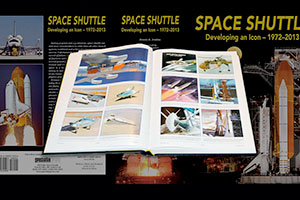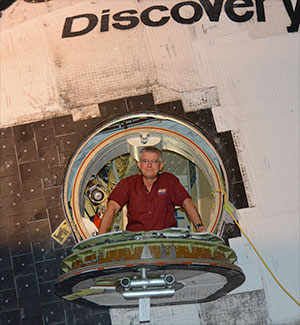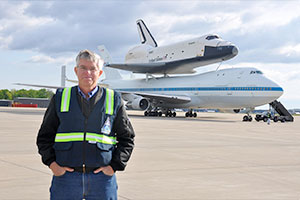March 7, 2017 — The history of the space shuttle, from its original proposal to its retirement after 30 years launching astronauts on 135 missions, can be a weighty topic.
Literally.
Tipping the scales at more than 18 pounds (8 kilograms), the new three-volume "Space Shuttle: Developing an Icon, 1972-2013" is author Dennis Jenkins' ultimate tome on the development, technology and flight campaign of the NASA reusable, winged launch vehicle. The comprehensive book includes 4,000 diagrams and photos, illustrating more than one million words.
"I think there are a lot of lessons to be learned from how we developed and operated the shuttle," said Jenkins, who worked as an engineer and manager throughout the length of the shuttle program. "I wanted to write as much down as possible to preserve the data."
Jenkins' first take on space shuttle history, written in 1988, addressed the first 25 missions. He then expanded on that 72-page "datagraph" in three subsequent hardcover books that covered the first 50, 75 and 100 missions, the last one published in 2001.
"Then we lost Columbia and [President] George W. Bush cancelled the program. At that point I decided I needed to completely rewrite the book," Jenkins told collectSPACE. "I really started concentrating on getting the book done after I returned from the Columbia accident investigation board, but there were a lot of distractions — such as shutting the program down and delivering the orbiters to their museum homes. That delayed the effort by a few years."
"That was probably good," Jenkins said, "since I managed to capture pretty much the very end of the space shuttle."
Presented as three, 528-page volumes (contained within a slipcase), "Space Shuttle: Developing an Icon" opens with a foreword by astronaut Story Musgrave.
"There will never be a better history of [the] space shuttle than this one," writes Musgrave, who was the only person to fly on missions on all five shuttle orbiters. "Jenkins was there, not just in time, not just in the paperwork, he, as is typical of his research, was there physically and spiritually with this machine at the critical junctures of its evolution; it was a personal and professional journey."
The first volume, "Setting the Stage," delves into how the National Space Transportation System — better known as the space shuttle — came to be, beginning with the advent of modern rocketry through the development phases that defined the vehicle's shape and purpose.
"I think I cover some parts of the program well, particularly the Phase A/B studies and development program," stated Jenkins. "The early pre-history makes up about half of the first volume."
The second book provides an in-depth description of the shuttle and its components, including "the famous bit," the winged orbiter; its RS-25 main engines; the "backbone of the stack," the external tank; and the solid rocket boosters. Jenkins also writes about the variety of "cans, stages and suits" that made up the orbiter's supporting hardware, such as Spacelab, Spacehab, the TDRSS satellite network and the extravehicular mobility unit (EMU).
The third volume examines the flight campaign, beginning before the first launch, STS-1, in April 1981, through to the end, STS-135, in July 2011, including full chapters devoted to the two accidents, Challenger and Columbia.
"The data tables [in the third book] present as much data on each mission as anybody could reasonably want," said Jenkins.
"Space Shuttle: Developing an Icon" is primarily meant to be a reference set aimed at space history enthusiasts, but earlier versions attracted a layman audience, "so this one may appeal to a wider audience," according to Jenkins.
"There are some chapters, including most of the first book, that are actually a continual story," Jenkins said. "But the second and third volumes are definitely reference works."
Jenkins avoids sharing his conclusions about the legacy of the space shuttle — his intent with the book was to inform future histories — but he does feel the lessons contained within the pages should be able to help build and operate much better vehicles in the future.
"I think the part a lot of people tend to forget is that STS-1 was only the 30th American crewed orbital flight. We had essentially no experience base when it began, so it all had to be learned on the fly," he explained.
As for the book's title, Jenkins said he wasn't sure how one truly defines an icon.
"I got the idea for the title watching and listening to visitors see shuttle Endeavour on display at the California Science Center and noting how often an image of a space shuttle appears on toys, games, advertisements and more. Maybe it's just because it was around for so long and most people alive today do not remember a time when the shuttle didn't exist, but it has certainly become ubiquitous in our society," he said.
"We will see how long that lasts now it is no longer flying," Jenkins said.
Dennis Jenkins' "Space Shuttle: Developing an Icon, 1972-2013" was published by Speciality Press in 2017. |
|

In the new "Space Shuttle: Developing an Icon, 1972-2013," Dennis Jenkins details the NASA spacecraft's history. (Specialty Press/cS)

"Space Shuttle: Developing an Icon, 1972-2013" by Dennis Jenkins includes 2,923 photos and 999 diagrams. (Specialty Press/cS)

Dennis Jenkins, author of "Developing an Icon," looks out through the crew hatch on space shuttle Discovery. (Dennis Jenkins)

Dennis Jenkins, author of "Developing an Icon," with space shuttle Enterprise atop the Shuttle Carrier Aircraft. (Dennis Jenkins) |
